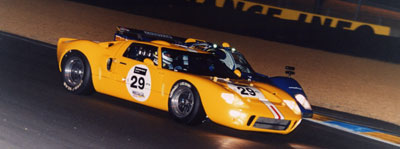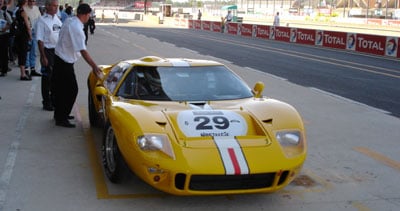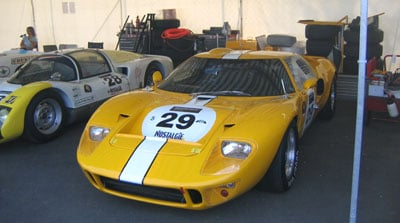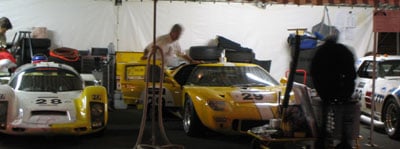Small wonder
Text:Steve Wakefield
Photos - Lynx
Everyone knows the story of Ford’s bid to win the classic French 24 Hour race in the 1960s. How they came close to buying Ferrari, but chose instead to use Lola’s basic design for an endurance racing car, finally winning the race after years of heartache and colossal expenditure with US-run 7-litre Mk IIs in 1966. They also produced around 100 4.7 litre cars, and 15 of them are at the 2004 Classic Le Mans, including this yellow, ex-Yamaha, chassis P/1077.
Whether holding on for overall success with the smaller-engined version would have brought success for Ford at a much-reduced budget is historical conjecture. John Wyer’s JW Automotive Team won Le Mans in successive years from 1968 - 69 with a highly-developed version of a heavy, only adequately powered (but reliable) car, five-years after its original concept and design. His opposition, in the form of a fleet of works Porsches, many of them driven by GP drivers (or at least long-distance experts) was no less effective than that offered by Ferrari, Chaparral and Lola in the immediately preceding years. John Wyer’s expertise, combined with an opening-up of the Ford purse for small-block development, may well have given the ‘Blue Oval’ a victory a year earlier - we shall never know.
The result of Ford’s decision to use the 7-litre Galaxie engine in its Mk II and Mk IV (factory supported, but teams run by Shelby American, Holman and Moody, Alan Mann and Ford France) cars from 1965 onwards meant the 4.7 was relegated to a privateer’s choice; slower than the more fragile Lola T70, but probably quicker and cheaper to run than a 250LM. Homologated as a GT car (in Group 4) the cars saw action throughout the world well into the early ‘70s.
It’s a well-known fact that Ford had trouble selling the GT40 in the ‘60s, the race-cars becoming old-fashioned and the road version Mk III a slightly inelegant and a bizarre choice compared to the equivalent Ferrari or Lamborghini. Nowadays of course a reasonable racing GT40 with proven provenance (important as there are a lot of dual-identity cars out there) will set you back £500,000+, and the company’s new ‘GT’ is causing ‘round-the-block’ queues at the local Ford dealership.
What the production Gp. 4 GT40, in mid-sixties racing guise, does well is perform reliably, just about seat two people (for the Tour Auto and Tour d’Espana retrospectives), have blistering performance - and is clothed in one of the most attractive coupé bodies ever designed.
A modern historic racer’s delight.


 Stay informed! Subscribe here to our weekly newsletter.
Stay informed! Subscribe here to our weekly newsletter.
Under the skin
Often described as ‘rumbling’, those who’ve actually heard a small-block GT40 on full-chat will know the crossover exhaust gives the car its uniquely hard-edged sound, a sonorous note that holds its own against anything with an additional four cylinders. The humble 289 has been tuned to within inches of its life over the years, and later developments included ‘dry-decking’ and Gurney-Weslake heads, plus a capacity increase to just under 5.0 litres (by stroking) giving ultimate power of 440 - 470bhp in 1969. Good enough to win Le Mans that year against Porsche’s newly-announced 917.
So with this powerhouse in the back, a sturdy sheet-steel and square-section tubing chassis, Formula 1 1960s-style suspension and rapidly expanding bodywork to cover ever-increasing tyre sizes, the wealthy privateer racer of the time had a vehicle par excellence with which to go long-distance racing all over the globe. It was an older car than the T70, and it had been designed with production and road-use in mind so it was less aerodynamic and heavier than it needed have been. Restorations of cars in the ‘80s and ‘90s have shown the steel monocoque to be prone to rust, and requiring a great deal of work (if not replacement, with consequent originality worries) to get it right.
The cars were originally equipped with alloy-rimmed Borrani spoked wheels, however once Carroll Shelby took over the project in 1965 he soon added Halibrand alloys, and in later years as rims got wider JW used magnesium wheels from BRM, as well as casting their own - ending up with 10” wide at the front and 14” rears. Hence the wide bodywork you will see on the later cars and the reason for pre-1966 models being classified differently at international historic meetings like the Le Mans Classic and Goodwood Revival.
Much was made of the interior design and trim of the car at the time. As a long-distance racing car, driver comfort and ergonomics were paramount. Compared with Ferrari’s time-honoured scattering of dials on the dash, a big Nardi wheel and simple blue cloth seat, the American company felt a statement needed to be made so introduced hi-tech seating of nylon mesh (with ventilating holes), as well as an angled instrument panel and computer designed internal airflow. The gear-lever fell to hand neatly on the driver’s right, and in common with racing-car practice all the cars were RHD. The driving seat was fixed in position and comfort was achieved by moving the pedals and steering wheel. In fact drivers of dramatically varying heights can be accommodated via clever seat engineering and a Dan Gurney ‘bubble’ driver’s door - witness diminutive Jackie Oliver paired with 6ft+ Martin Colvill in the latter’s Gulf-painted car.


On the track
The car you see here is chassis number P/1077 (originally built as a sister car to the Gulf cars, and shares their specification), delivered to the Yamaha Motor Company in 1968 for testing and evaluation purposes. It was raced twice at Suzuka in 1970, before being retired and joining a significant private Japanese collection for many years. Returning to England in 1999, it was rebuilt and prepared for competition by Lynx Motors International, and has since competed in the Whitsun Trophy races at the Goodwood Revival Meetings in 2001, 2002 and 2003, driven by Lynx Chairman, John Mayston-Taylor.
John Horsman, John Wyer’s deputy at JW (who in addition to running their own team handled much of the competition car sales and preparation for Ford Advanced Vehicles) remembers the car ‘It left the factory in yellow with a white stripe,’ he says. ‘It had a 289 fitted with the aluminium Gurney-Weslake heads. It had the lightweight roof and body panels, and Stage Two ventilated discs, the best brakes we had at the time. It had silver springs and the orange Konis fitted to the works cars, and it had the 8.5" and 11" wheels, so it wasn’t quite up to the Le Mans spec, but it was close. A good car. It wouldn’t have taken much too convert it into works spec.’
Mayston-Taylor has carried out a meticulous restoration of the car for its current owner and is behind the wheel again at the Le Mans Classic. Here are his driving impressions -
"The very low driving position and shape of the cockpit tends to cocoon you. Initially one feels a little claustrophobic when stationary, but once moving the circuit opens up in front of you as if the windscreen has suddenly grown in size! As with all great cars, the faster you drive, the smaller the car feels. The car exudes confidence with its solidity and superior engineering. The GT40 was built as a racing car (and not as a modified road car) with a single purpose - to win at endurance racing. With its steel monocoque and extremely comfortable driving position, the car was built for long distance events and it is as its most composed and comfortable in this environment.
"As the GT40 was built at a time when ideas of ground effects and downforce were just beginning to be developed, it is extremely important that the set up and balance of the car is correct, as any variation in the set-up will be very evident to the driver and of course is magnified the faster you drive! With a final drive ratio installed for Le Mans, 1077 will be approaching 190mph at 6,200 in top (fifth). Pause for thought! The feeling of accelerating hard up through the gears after Mulsanne corner on the run down to Indianapolis is an addictive feeling and one that is difficult to beat in my opinion. The sound of the raspy engine note immediately behind your left ear reminds you that you are driving a GT car from the golden era.
"Chassis 1077 was built as a spare car for the Gulf team in 1968, so it shares the same Le Mans specifications as its sister cars. Lighter bodywork, Le Mans-spec brakes and a slightly different gearbox. As it ended up being sold to Yamaha in Japan after is was completed in March 1968, 1077 never had the opportunity of running at Le Mans - until now - some 36 years later. The circuit may have changed, but the sound and sensation of driving the car at its spiritual home is truly an experience of a lifetime."
Editor's note; we are indebted to John Mayston-Taylor, of Lynx Motors for his help in preparing this article and giving his view 'from the cockpit'. Famous for their superbly crafted D-type, C-type and Lightweight E-type Jaguar recreations, the company has also prepared a multiple-concours-award winning Ferrari 250GT Lusso and the awesome 725bhp twin-turbo Aston Martin Virage.


The facts:
A typical MK1 production racing Gp.4 GT40 c.1966 - 1968
| Engine: | 4,736cc cast-iron V8; bore and stroke, 101.6mm x 72.9mm; two valves per cylinder, single overhead pushrod-activated cam, 10.1 compression ratio, dry-sump, 4 x 48IDA Weber carburettors |
| Power: | c.350bhp @ 7,200rpm |
| Torque: | 330lb ft @ 5,500rpm |
| Transmission: | 5-speed ZF DS25 transaxle gearbox with 7 1/4" Borg & Beck triple-plate clutch |
| Chassis/body: | Semi-monocoque sheet steel chassis with square tube stiffening. Reinforced glass-fibre 2-door coupe bodywork. Special alloy-bodied cars were made by Alan Mann Racing, and JW Automotive pioneered the use of carbon-fibre in racing cars |
| Suspension: | Front; Independent, double wishbone with coil springs, shock absorbers and anti-roll bar Rear; Independent, upper and lower trailing arms with transverse upper link and lower wishbone, coil springs, shock absorbers and anti-roll bar |
| Brakes: | Front and rear: 11.5" Girling discs - ventilated on later cars |
| Steering: | Rack and pinion. 14:1 ratio, 37ft turning circle |
| Wheels/tyres: | Dependent on specification. Typical set-up; Front; 15 x 8" Halibrand alloy wheels with 5.50 x 15" Goodyear or Dunlop racing tyres Rear; 15 x 9.5" Halibrand alloy wheels with 7.00 x 15" Goodyear or Dunlop racing tyres |
| Dimensions: |
4178mm/164.5" long; 1778mm/70" wide; 2413mm/95" wheelbase.
Height: 1030mm/40.5" Fuel tank capacity: 30.5 Imp Galls (37.0 US) Weight (approx): 900kg/2000lbs |
| Price when new: | In 1966 c. £6,648.00 icluding purchase tax. (A Ferrari 250LM was £9.450.00). |
| Value now: | A good example with impeccable credentials is worth £500,000+. Pay more for ex-Team cars such as Gulf, Filipinetti or Essex Wire |
| Max speed: | Dependent on final drive ratio. Typically 170 - 190mph |





